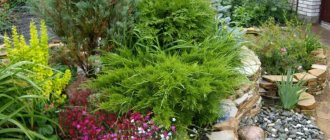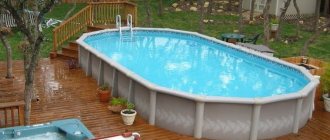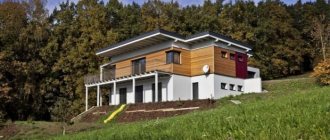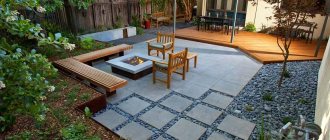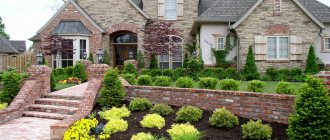Every new day, professional landscape designers come up with original ideas for designing a garden, patio and dacha area in general. In this regard, new styles of landscape design are born. Today we want to talk about minimalism, which came into the landscape not so long ago, but has already taken a fairly stable position.
Garden design in the style of minimalism is as similar as possible to minimalism in the interior - everything is quite simple, restrained, laconic, but expressive. But it’s only at first glance that everything seems so simple; in fact, creating “real minimalism” in the garden is quite difficult. The most important thing is that with a minimum of details, objects and their arrangement, it is necessary to ensure that the area presented at the disposal of the designer begins to sound. If a professional designer works with your site and manages to recreate the garden design in the minimalist style as much as possible, then caring for such a garden will be very easy.
Minimalism is applied to a plot of any size, but it is much more interesting to work with small plots of 3-8 acres, from which, through knowledge and its implementation, you can create a real miracle.
The minimalist style is primarily intended for people who prefer laconicism and restraint, surrounded by modern elements of landscape design.
Key elements
Like any style of landscape design, minimalism has its own special elements, which distinguishes it from other styles, and also appeals to the customer. Among them:
- a large amount of paving;
- the main attention is paid not to color and shades, but to the shape of objects and elements, and their size;
- podiums and steps are expected;
- minimum number of outbuildings;
- several large patios, wooden decks;
- the use of some large coarse elements;
- one body of water, most often of regular geometric shape, possibly elevated, with a fountain or cascade;
- the use of only one material in construction and production, for example, all walls, paving, benches, fences, etc. are made of concrete.
Signs of a minimalist style in site design
Minimalism, like any other design style, is characterized by completeness of composition. All items and objects harmoniously complement each other, creating a single image. The ultimate goal of design is the continuation of the natural principle in its pristine harmony, purity, and ease. The beauty of the landscape is emphasized by the quality of materials, a competent combination of shapes, structures and color schemes.
This type of site design is characterized by the following features:
- Space. This is the most important component of designing a minimalist garden. Architectural objects, flower beds, plantings should occupy only a small part of the territory. The emphasis is on open space, creating a feeling of freedom.
- No frills. A laconic design, in which there is no place for pretentious decorative elements and bulky objects, emphasizes the beauty of nature. Forest, land, water, grass become the main components of the suburban landscape. Artificially erected buildings and structures are intended only to complement the natural landscape.
- Clear geometric lines - a landscape in the minimalist style is characterized by regular straight lines that create the effect of psychological stability, cleanliness, and neatness. The design uses predominantly horizontal, vertical, and diagonal directions.
- End-to-end zoning. This technique is used to visually increase space. The area is divided into zones conditionally using floorings, paths, and flowerpots. A suburban studio plot is suitable for organizing open sports grounds for tennis, badminton, and golf.
Upon completion of the work, the landscape should be perceived as a single whole: a spacious area without disconnected elements and disharmonious buildings. It must be functional, neat, well-groomed, and effective.
An example of a minimalist landscape is the courtyard of the New York Museum of Modern Art, the National September 11 Memorial and Museum, and the Rock Garden in the Japanese city of Kato.
Layout features
Features of the layout also indicate the features of the style, its differences and positive characteristics, as well as some technical data:
- use of a small number of details in design;
- observance of clear lines and shapes of each building, each landscape element;
- steps in the garden and paving of the original shape - rhombuses, triangles, etc.;
- observance of unusual combinations of elements, plants, buildings in space;
- maximum emphasis from the general appearance of the clarity of lines, shapes and sizes of architectural forms;
- zoning of the site due to various differences in the departments of the site;
- mandatory division of the area to be improved into certain zones;
- using differences in the relief of a site for design, or creating them artificially and further using them.
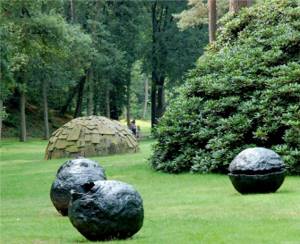
What plants are suitable
What plants does a minimalist garden landscape design include? Trees should become a vertical accent; they are located at the edge and, very rarely, in the middle of the lawn. Shrubs soften corners and differences.

To decorate stone compositions, use decorative mosses and other herbs:
- tenacious Multicolor or Atropurpurea;
- mossy saxifrage;
- Plantain Rubra;
- Thyme Aureus.
To soften the corners of paving and decking, minimalism uses:
- marigold;
- geranium;
- irises;
- Capuchin;
- cuff;
- spurge;
- primroses;
- chamomile;
- succulents.
It is quite acceptable to use vertical gardening (creating hedges). Traditionally, modest climbing plants are chosen for it:
- actinidia kolomikta;
- maiden grapes;
- lemongrass;
- decorative pumpkin;
- ivy;
- hop.
Of the herbs and flowers, preference should be given to the former (for example, pampas grass), since the riotous flowering of the latter can disrupt the elegance and restraint of the created composition.
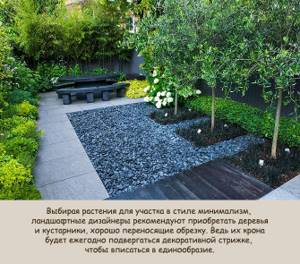
Plants in minimalism
Minimalism has no special preferences in plants; in many of them, minimalism intersects with other styles of landscape design:
- Trees - willow, spruce, weeping birch, chestnut, columnar juniper, various pines, blue spruce, thuja, columnar apple and maple;
- Shrubs - forsythia, spirea, snowberry, rhododendron and some other decorative and expressive shrubs;
- Flowers and perennials - actinidia, pumpkin, and virgin grapes are used for vertical gardening. To soften floorings and paving corners - nasturtium, mantle, primrose, marigold, chamomile, irises, and some other ground-blooded plants. Sunflowers, canna, buzulnik, ferns, mosses, sedges and grasses are also used.
Selection of colors
Those who independently try to organize their site in a minimalist style often make mistakes when choosing colors. No, no, and I want to add some color to this corner of the garden, then to this flowerbed. In landscape design there are certain rules in this regard. Neglecting them can put the whole idea in jeopardy.
- In minimalism, you can use only the most restrained colors.
- Their number is limited.
- It is allowed to make only 2-3 bright accents throughout the entire area.
The main range should be in the following shades:
- beige;
- white;
- green;
- earthen;
- brown;
- sandy, turning into gold;
- silver, giving off a metallic look;
- grey;
- terracotta;
- cold blue.
When choosing a color scheme, do not forget about uniformity. If it is predominantly light, you should not mix it with dark shades. And vice versa.
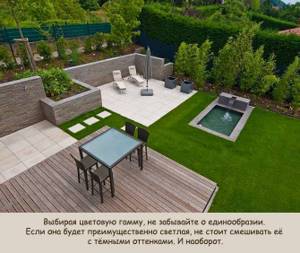
Small architectural forms
Without architectural forms, not a single style of landscape design is possible, and the design of a site is impossible even without the use of any style. Accordingly, minimalism has its own requirements for small architectural forms in landscape design:
- a simple gazebo in the form of a canopy;
- large paving areas;
- large boulders throughout the site;
- wooden flooring, preferably multi-level;
- mulch of certain areas from pebbles and crushed stone;
- many stone, brick, concrete elements;
- several raised flower beds;
- lawn, vertical gardening possible;
- unusual installations of abstract forms;
- bamboo, expressive driftwood, logs;
- mirrors, balls, geometric shapes in light metallic color;
- containers for plants - cylinders and cubes of different sizes;
- modern, simple furniture made of metal or the use of decking and borders as furniture;
As you can see, at first glance everything is simple - prepare a site, plant certain plants, arrange everything correctly according to the design project, fill the territory with a certain number of small architectural forms... yes, it’s simple only at first glance, but how can you do this in practice without the necessary knowledge and experience?
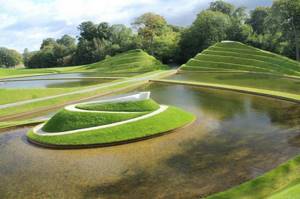
Maybe it’s still better to overpay a little and call a professional landscape designer to the site, so that in the future you don’t have to redo everything and pay again, but more? Everyone makes their own decision, because they have the right to do so. If there is some capital that a person is ready to invest in the landscape design of his own site and arrange real minimalism there, then, of course, you should use the services of a professional; if not, and you decide to do everything yourself, then you should listen to the advice of professional landscapers:
- to create a minimalist style, it is possible to use any modern and traditional materials;
- Difficulties may arise with plants, as this is a real art. In addition to the fact that all plants are unique, they are designed to unite your entire garden into one whole, into a real composition;
- containers for plants can be of different sizes and shapes, but it is better that they are closer to the same;
- An excellent move is considered to be the combination of some different buildings into a single whole, for example a gazebo and barbecue complex.
These are only individual opinions of professionals who advise how best to use the available resource and site to build the desired style on it, but if you take all the advice of landscapers into account, you can either do everything perfectly, or even get a little confused.
Furniture and decor for the garden in a minimalist style
The decor and furniture in a minimalist landscape are characterized by simplicity and asceticism. Rest benches are constructed in the form of straight crossbars mounted on cubic supports or containers with vegetation. Hammocks, sun loungers, and umbrellas do not fit into the design concept, so they are completely abandoned. It is permissible to install tables and chairs in the recreation area, but it is necessary that they support the overall style: they are simple, functional, and discreet.
Containers for plants are chosen in the shape of a cube or cylinder. Preference is given to steel and ceramic forms. In the garden it is permissible to place abstract sculptures, stone balls, mirrors, expressive driftwood, and bamboo trunks.
Properly selected lighting enlivens the garden in the evening and gives it an almost mystical charm. Illuminated sculptures, groups of plants, individual trees, and a pond look unusual and attractive against the backdrop of a laconic night landscape.
Minimalism in landscape design (20 photos)
Materials
When choosing a material that will become the basis for decorating a site in a minimalist style, keep in mind that it should not be flashy. What do landscape designers recommend?
- Wood
It will become the main material if there are many multi-level decking, patios, gazebos, and benches on the site. Wicker plant containers fit perfectly into this design.
- Concrete
Most areas are covered with polished concrete. It can be used to make containers for plants.
- Stone
Expensive, but stylish. Combines with polished concrete platforms.
- Gravel
They can dilute the severity of the uniformity of materials. Use it for backfilling as an independent decorative component.
- Unglazed ceramics
Ceramic containers look beautiful and stylish.
- Metal and glass
Despite the fact that decorative elements in minimalism are strictly prohibited, a couple of stylish things will make it even more sophisticated and unusual. And this is where metal and glass come to the rescue. Abstract sculptures, original installations, garden sconces and street lamps - for those who find this genre too boring.
When choosing a material, do not forget about the calculations. Find out in advance how much it costs and how much you will need. This is one of the main expense items when designing a minimalist garden.
A little about minimalism
Minimalism (from the Latin minimus - smallest) is rather not a separate style, but a direction in contemporary art of the 20-21st centuries. It is characterized by simplicity of form, a limited number of components, geometric shapes, and a natural color palette.
The early prerequisites of the style in question can be seen in constructivism at the beginning of the last century. The artist society De Stijl (Dutch Style), formed in Leiden in 1917, developed the concept of a new style - clarity, concreteness, engineering purity. These principles received feedback from artists, architects, and sculptors. However, the greatest influence on the emergence of minimalism was Japanese culture and design. Its tendencies penetrated the West after World War II. At that time, the saturation of decorative components was irrelevant, and the introduction of new technologies and the development of new philosophical movements dictated their implementation in design. For famous architects of the time, the mottos became “Less is more” and “Do more with less.”
Simplicity, strict forms, a combination of natural colors are characteristic features of modern minimalism. The designer’s task is to create a composition without unnecessary elements. The site must be functional. This result can be achieved using clear geometric shapes and thoughtful lighting. But geometry here does not mean symmetry. Emphasis on strict composition. Minimalism in landscape design is neatness, well-groomed, functionality and elegance.






